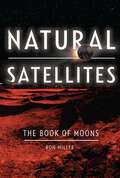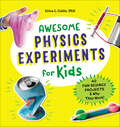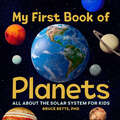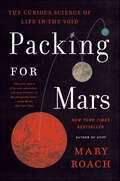Title search results
Showing 1 - 5 of 5 items

Natural Satellites: The Book of Moons
By Ron Miller. 2021
For centuries, astronomers have placed a special importance on the other planets of the solar system. But with the advent…
of spacecraft and the tremendous missions undertaken by the Voyager and Cassini probes, astronomers have discovered that the natural satellites of the planets—the solar system's moons—are some of the most extraordinary places imaginable. There are moons with towering geysers, erupting volcanoes, and subterranean oceans of warm, mineral-rich water. Some of the highest mountains and deepest canyons can be found on moons. There are moons that have shattered into pieces and then reassembled. There is even a moon where it rains rocket fuel. Recently, scientists have turned to moons for answers in their investigations of the origins of the solar system and the evolution of life on our own planet. Featuring full-color, scientifically accurate illustrations by NASA artist Ron Miller, Natural Satellites: The Book of Moons chronicles these investigations and the questions we have yet to answer in our exploration of the solar system's moons.
Get kids excited about physics with fun and easy experiments for ages 10 to 13 Turn living rooms into STEAM…
laboratories and watch as children have an awesome time learning about physics. This book contains 40 highly entertaining, hands-on experiments that can be completed using simple, household materials.What sets this physics for kids book apart:Excellent explanations—Brief explainers address the hows and whys of each experiment, providing children with a clear understanding of the fundamental concepts surrounding force, flight, and much more.Step-by-step instructions—Full-color photos and easy-to-follow instructions allow kids to confidently conduct experiments on their own, with only the occasional assist from an adult.Extended fun—Each experiment contains a "Now Try This!" section that offers ideas for further investigation and expands the possibilities for learning.Help kids set off on a journey of scientific discovery with 40 fun physics experiments they can tackle at home.
My First Book of Planets: All About the Solar System for Kids (My First Book of)
By Bruce Betts. 2020
Blast off on an exploration of outer space with this colorful solar system book for kids 3-5Get little astronomers excited…
about the cosmos—from the bright and burning sun, to our own blue Earth, stormy Neptune, and every planet in between. With this incredible exploration of planets for preschool and kindergarten kids, curious learners will discover the ultimate solar system book, featuring amazing pictures and fascinating facts about what makes each planet so special, including its size, distance from the sun, what the surface is like, how many moons it has, and more!Go beyond other planet books for kids with:BIG, BEAUTIFUL IMAGES: Vibrant photos and illustrations will take kids deep into space—no telescope required.ASTRONOMY FOR KIDS: Learn all about the eight planets in our solar system, plus dwarf planets Ceres, Pluto, Eris, Haumea, and Makemake.FUN SPACE FACTS: Did you know the bubbles in soda are the same gas that's on Venus? Out of this world facts will make this toddler space book a hit!Show kids the amazing universe that surrounds them with My First Book of Planets.
Details the life of a female Chinese American physicist who was a pioneer in the field during a time when…
girls were not considered to be as smart as boys. PRINT/BRAILLE. For grades K-3. 2019
Packing for Mars: The Curious Science of Life in the Void
By Mary Roach. 2010
“America’s funniest science writer” (Washington Post) explores the irresistibly strange universe of life without gravity in this New York Times…
bestseller.The best-selling author of Stiff and Bonk explores the irresistibly strange universe of space travel and life without gravity. From the Space Shuttle training toilet to a crash test of NASA’s new space capsule, Mary Roach takes us on the surreally entertaining trip into the science of life in space and space on Earth.